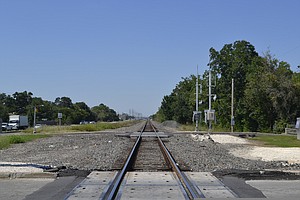9/23/2022

The Houston Health Department began notifying residents today that surface soil samples collected in July around the contaminated Union Pacific rail yard and tested by the department contain dioxin, a highly toxic chemical compound associated with cancer and other severe health risks.
Laboratory analysis received by the department indicates all 42 collected soil samples were contaminated with dioxin. Additionally, 27 percent of the dioxin sample concentrations exceed the Environmental Protection Agency's (EPA) non-carcinogenic risk-based screening level of 51 nanograms per kilogram in soil for children.
Testing of the soil samples from residential properties and right of ways indicates the highest concentrations of the chemical are at the fence line and decrease in areas farther away from the 33-acre site.
The property is a former railroad creosote treatment facility located in the Fifth Ward and Kashmere Gardens neighborhoods near the intersections of Liberty Road and Lockwood Drive and Liberty Road and Altoona Street. Creosote treatment at the site began in 1899 and did not cease until 1984, resulting in soil and groundwater contamination.
“These tests results raise an added level of concern. No longer are we just talking about a dangerous plume beneath the surface, but a cancer-causing substance, dioxin, at the surface level. UP and the state must now change their entire remediation plan,” said Mayor Sylvester Turner. “We have promised residents that the city will continue to test, monitor and work in their best interest.”
Even though the laboratory analysis recommends additional sampling, there is a strong link between environmental conditions within these communities and human health, said Stephen L. Williams, the department’s director.
Today the department began notifying residents of the test results in person if soil samples were taken from their properties or immediately adjacent areas. It started notifying neighborhood and community leaders from the Fifth Ward and Kashmere Gardens and elected officials yesterday.
The department also provided the sampling results to the EPA, Texas Department of State Health Services (DSHS) and Texas Commission on Environmental Quality (TCEQ) for further action.
Dioxins are a group of toxic chemical compounds that can cause certain types of cancer, reproductive and developmental problems, damage to the immune system and can interfere with hormones. They are considered persistent organic pollutants by the EPA because they take a long time to break down once in the environment.
The department today published the full report of the results and a map with all of the soil sampling locations on its website
Although the contaminated site falls under the jurisdiction of the TCEQ, the health department is taking steps to fill in gaps to address community concerns. It will continue its efforts to support the community.
In November 2019, the department contacted DSHS to request a cancer cluster analysis. DSHS informed the department that an analysis had been completed four months earlier at the request of TCEQ.
The department and the community group IMPACT conducted a community survey of the 110 properties located over the contamination in January of 2020. The data helped the health department better understand the health needs in the area.
Early in 2021, DSHS issued a report to the department detailing an analysis of the occurrence of childhood acute lymphoblastic leukemia and adult kidney and renal pelvis cancers in census tracts around the rail yard. The analysis found a higher-than-expected cancer rate of acute lymphoblastic leukemia at nearly five times the expected rate.
A more extensive timeline is available on the department’s website.
.
